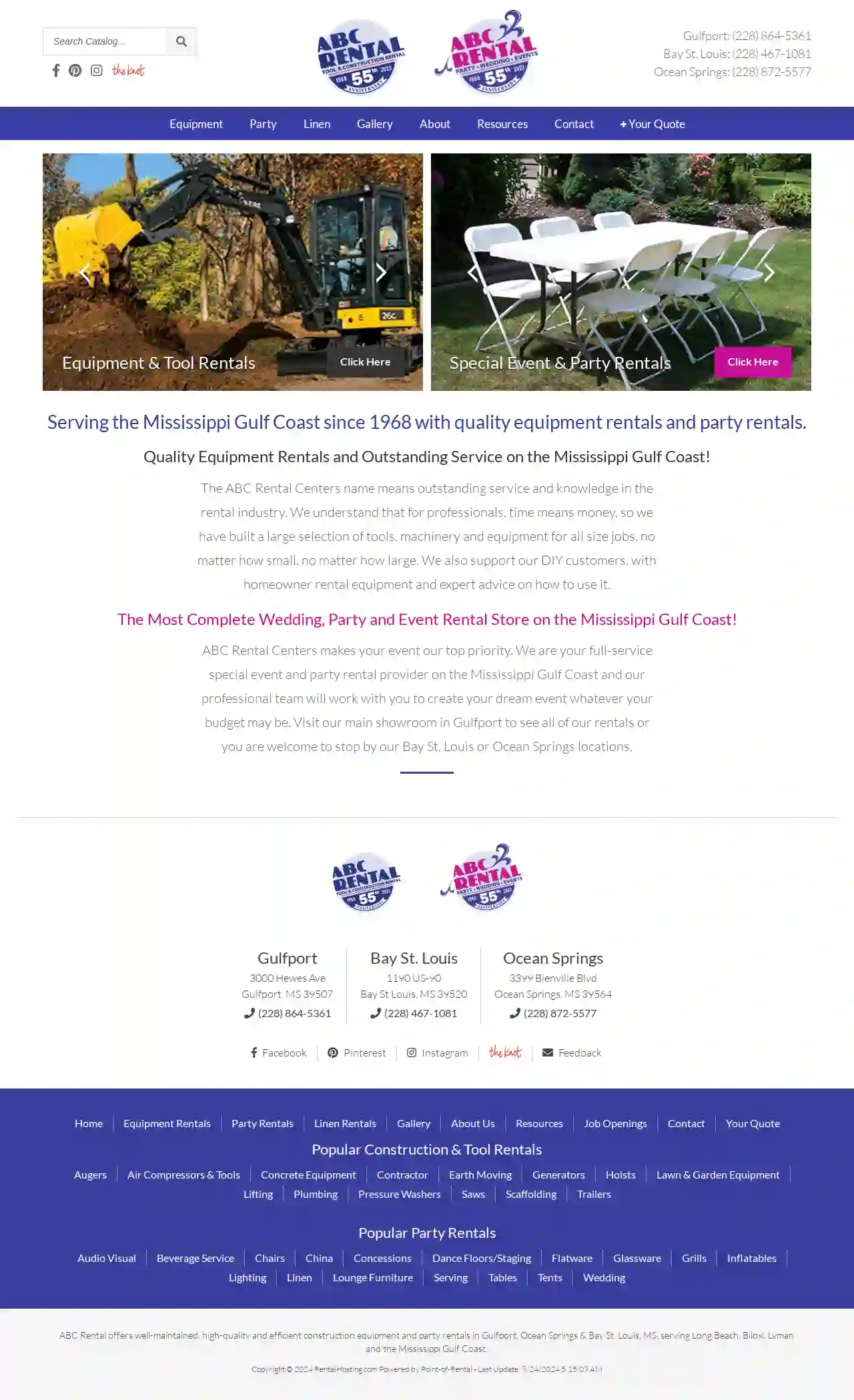Scaffolding Rental Gautier
Top 10 Scaffolding Rental in Gautier
Receive up to 3 Affordable Scaffolding Rental quotes for your project today! Compare profiles, reviews, accreditations, portfolio, etc... and choose the best service.
Service Needed
City or Town

ABC Rental Center
4.4151 reviews3000 Hewes Ave, Gulfport, 39507, USABC Rental offers well-maintained, high-quality and efficient construction equipment and party rentals in Gulfport, Ocean Springs & Bay St. Louis, MS, serving Long Beach, Biloxi, Lyman and the Mississippi Gulf Coast. With a wide range of equipment and party rentals, ABC Rental is dedicated to providing outstanding service and knowledge in the rental industry.
- Services
- Why Us?
- Gallery
Get Quote- Ma
Magnolia Masonry of South Mississippi LLC
4.914 reviewsGulfport, US- Services
- Why Us?
Get Quote - Th
The Home Depot
4.2Gulfport, US- Services
- Why Us?
Get Quote - Cr
Crom Equipment Rentals Inc
Gulfport, US- Services
- Why Us?
Get Quote - Lo
Lowe's Home Improvement
4.1Gulfport, US- Services
- Why Us?
Get Quote
Over 2,353+ Scaffolding Contractors in our network
Our scaffolding companies operate in Gautier and surrounding areas!
ScaffoldingHQ has curated and vetted the Best Scaffolding Companies in Gautier. Find a reliable contractor today.
Frequently Asked Questions About Scaffolding Rental
Get answers to common questions about scaffolding rentals and finding the right scaffolding rental company in the USA.
- General Liability Insurance: Provides coverage if someone is injured or property is damaged due to your use of the scaffolding.
- Worker's Compensation Insurance (if you have employees): Covers medical expenses and lost wages for employees injured while working on the scaffolding.
- Construction: Building new structures, adding extensions, and performing facade work.
- Renovation and Repair: Repairing or replacing roofs, siding, windows, and gutters.
- Maintenance: Cleaning windows, painting, and performing general upkeep on buildings.
- Industrial Work: Accessing elevated equipment, performing inspections and repairs on industrial structures, and carrying out construction work in industrial settings.
- Events: Creating temporary stages, grandstands, and platforms for concerts, festivals, and sporting events.
- Small Repairs or Painting: A rolling tower or mobile scaffolding is often sufficient for smaller projects, providing a stable platform at lower heights.
- Roof Work: Roofing projects typically require taller and more robust scaffolding, like tube and clamp or system scaffolding.
- Two-Story Homes: For accessing higher levels of a two-story home, you may need a larger system scaffolding structure.
- Limited Access: If space is restricted, consider a narrow-width scaffolding tower or suspended scaffolding.
- Scaffolding Boards: Wooden planks or metal grating that form the working platform.
- Base Plates: Provide a stable foundation for scaffolding legs, often adjustable to accommodate uneven ground.
- Ladder Access: Ladders or stairs allow safe access to and from the scaffolding platform.
- Castors (Wheels): Used for mobile scaffolding, allowing for easy movement.
- Braces and Ties: Strengthen and stabilize the scaffolding structure.
- Safety Nets: Catch falling objects and prevent debris from reaching the ground.
- Weather Protection: Screens or covers protect workers from wind, rain, or sun.
Do I need insurance to rent scaffolding?
It's highly recommended to have insurance coverage when renting scaffolding. While the rental company typically has insurance to cover their equipment, it's essential to protect yourself from liability in case of accidents or damage:
What is scaffolding used for?
Scaffolding provides a temporary working platform for a wide range of applications:
What type of scaffolding is best for home use?
The best type of scaffolding for home use depends on the project:
What are some common scaffolding accessories?
Scaffolding accessories enhance functionality and safety:
Do I need insurance to rent scaffolding?
It's highly recommended to have insurance coverage when renting scaffolding. While the rental company typically has insurance to cover their equipment, it's essential to protect yourself from liability in case of accidents or damage:
- General Liability Insurance: Provides coverage if someone is injured or property is damaged due to your use of the scaffolding.
- Worker's Compensation Insurance (if you have employees): Covers medical expenses and lost wages for employees injured while working on the scaffolding.
What is scaffolding used for?
Scaffolding provides a temporary working platform for a wide range of applications:
- Construction: Building new structures, adding extensions, and performing facade work.
- Renovation and Repair: Repairing or replacing roofs, siding, windows, and gutters.
- Maintenance: Cleaning windows, painting, and performing general upkeep on buildings.
- Industrial Work: Accessing elevated equipment, performing inspections and repairs on industrial structures, and carrying out construction work in industrial settings.
- Events: Creating temporary stages, grandstands, and platforms for concerts, festivals, and sporting events.
What type of scaffolding is best for home use?
The best type of scaffolding for home use depends on the project:
- Small Repairs or Painting: A rolling tower or mobile scaffolding is often sufficient for smaller projects, providing a stable platform at lower heights.
- Roof Work: Roofing projects typically require taller and more robust scaffolding, like tube and clamp or system scaffolding.
- Two-Story Homes: For accessing higher levels of a two-story home, you may need a larger system scaffolding structure.
- Limited Access: If space is restricted, consider a narrow-width scaffolding tower or suspended scaffolding.
What are some common scaffolding accessories?
Scaffolding accessories enhance functionality and safety:
- Scaffolding Boards: Wooden planks or metal grating that form the working platform.
- Base Plates: Provide a stable foundation for scaffolding legs, often adjustable to accommodate uneven ground.
- Ladder Access: Ladders or stairs allow safe access to and from the scaffolding platform.
- Castors (Wheels): Used for mobile scaffolding, allowing for easy movement.
- Braces and Ties: Strengthen and stabilize the scaffolding structure.
- Safety Nets: Catch falling objects and prevent debris from reaching the ground.
- Weather Protection: Screens or covers protect workers from wind, rain, or sun.